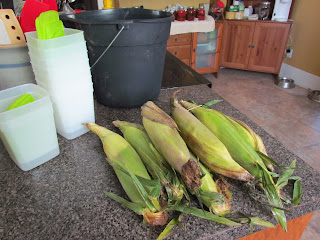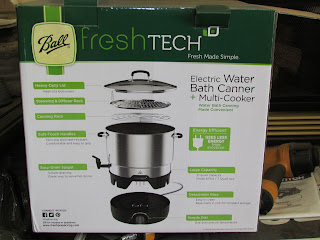I'm not sure why my posts don't post as scheduled! I had this set to post on Halloween Day. It obviously didn't go out! Oh well, it's still an interesting piece to share about our farm's history, so here you go (with revisions made to suit the timing).
Halloween seems like an appropriate time, to deviate from farm tales and tell you a bit about our 186 year old farm house that we live in! Why an appropriate time? It's Halloween season and yes, our house has it's share of odd events! Haunted? I guess that depends on your perspective. There are many events that are definitely not explainable by logical avenues!
Here's a bit of the house's history. It was built in 1830 by a gentleman that was engaged to be married. He had to complete the house, before his marriage. He accomplished that task. It was a simple 2 story, antebellum farmhouse. (When it was first built, it did not have the front porch and columns. Those were added during a renovation in the 1960's.) I believe it began life as a saltbox style house. It was 1 and 1/2 stories with an additional single story at the back of the house for the kitchen and back porch. During it's renovation in the mid 1900's, a covered front porch with columns was added to it, along with bathrooms, a laundry room and the back porch enclosed and incorporated into the living area of the house. Then in the early 2000's, it had another addition made to it. A garage was added on to the east side. We since have turned the original garage into a storage area and dog kennel. We've also added a new garage on further to the east and a new master living area onto the west side.

The house resembled a modest plantation house in it's birth. The farm was a large cotton farm with a share cropper's house on the property too (that house is now gone). They also raised cattle and had work horses, so many barns were here too. Over the years, the farm has dwindled down to 13+/- acres.
There used to be a huge cedar tree, out by the main gate that goes to our barns now. That tree came down during Hurricane Hugo, back in 1989. Anyway, the significance of that tree and why it's stump has been left (and we will continue to leave it there), is that General Sherman's army is said to have camped under and around that tree! They did not destroy the house or the barns, for which we are thankful all these years later!! We only have hearsay to document this story though. We have never found any artifacts from the army.
We HAVE found Indian artifacts though! Every time it rains, our sandy soil offers up arrow heads, spear heads and other rocks that were used by the Indians. This is reported to have been one of their camping sites. Which tribe was here, we are not sure. It could have been a hunting ground of the Catawba's, the Waxhaw's, the Cheraw's or even the Wateree's. We're fairly certain it was not a permanent Indian Village site, but just a hunting camp area for them.
So as you can see, the land and house have a long and interesting history! The farming families that have lived in the house, LOVED this house and land. It's no wonder that they might wish to stay!
We've lived here for 7+ years. We fell in love with the house, farm and general location the minute we saw it! Right from the beginning though, odd things would happen.......
When I "met" the house for the first time, I felt as though I had been here before. I knew my way around, without being told where to find doors or stairs, etc. It was a comforting feeling, yet odd just the same. In an upstairs bedroom, when I opened a closet door, little plastic BB balls came falling down across the floor. On further inspection, there wasn't any shelf or ledge that they could have been located on, in order to fall like that! A little different, but nothing to scare me.
We bought the house and moved in. It had been empty for about a year. While the house was in good repair, there was a lot of cleaning and things to be done. We soon noticed that a particular light switch on the staircase would turn on by itself! There was an upstairs bedroom that had a light switch and ceiling fan that had a mind of it's own as well (this was NOT the bedroom that had the plastic BB's fall). The front doors would open on their own, if the deadbolt was not latched. An upstairs window (same bedroom as the independent light switch) would open a few inches on it's own, as did a window in the downstairs living room!
There were cold spots that would occur, mostly in the living room. We had a house cat and he would act as though he saw something moving, that none of us could see! We added a new puppy to our family that same year we moved in and he would "watch" something go from the front doors, down the center of the entry hall and then he would look up the stairs, as if he were watching something go upstairs!
A couple of years later, we added another puppy to the family. She, too, would look at the front doors and growl, with the hair on her back standing on end! Then she would quite clearly watch something move down the center entry hall and up the stairs! Only after "it" was at the top of the stairs, would she come back and lay down again in the living room! After a month or so, she would still look at the front door at times, but then she would wag her tail and roll over for a belly rub to something unseen to us!! Apparently whatever/whomever this was, was friendly and of no threat to us!! It still made me sit up and take notice though, I can sure tell you that! LOL
We've also heard voices or a conversation (2 voices) coming from outside, on the west side of the house. That phenomenon continues now, even though we've added on to that west side and you can hear the voices inside the new hallway there! It only happens a few times a year and one of the previous owners said they had the same experience. He had even went outside to look for prowlers (as did we) and found no one, nor could he hear any voices carrying on the wind or echoing outside.
I believe the oddest thing I've witnessed here, was a fork move on it's own! We have an island in the kitchen. Three of us were sitting at the island eating breakfast. The stove sits on the other side of the island and had a pan still sitting there. We had placed a fork on the edge of the pan. Two of us quite clearly saw the fork lift up and be placed down on the edge of the counter. It didn't fall. It lifted up and turned itself over to be sat down, just as it would look like if we were doing that ourselves!!
We also used to smell bacon cooking in the kitchen quite often. I would come in the back door and think "Oh good, Shaun (my husband) is making breakfast!" Then I'd come on into the kitchen and NOTHING! No cooking of any kind was going on or HAD gone on!!
A lot of our pictures seem to have "orbs" in them also. This happens mostly around the baby animals, but can happen around the horses in the field too. I know, people will say dust particles! However with rapid sequence photography, there might be 1 or 2 pics out of 10 that have any abnormalities in them. If it were dust in the air, I'd think there would be quite a bit more photos with those particles visible in them! I think whoever it is, likes the animals and especially the babies.
 |
| Orb to the right of the pup's neck. |
 |
| Large orb near the colt's front legs. |
 |
| Orb located centrally, near the head of the middle black and white horse. |
We certainly don't feel threatened at all. I think there are a couple of "people" that have stayed around here, at least. The main one seems to be the previous farm owner. I think he loves the place as much as we do and just hasn't moved on yet.
I hope you enjoyed the history on our house! Enjoy the fall weather everyone. Since the holidays are upon us, the next post will be the first week of December. I wish you all an early Happy Thanksgiving!



























































